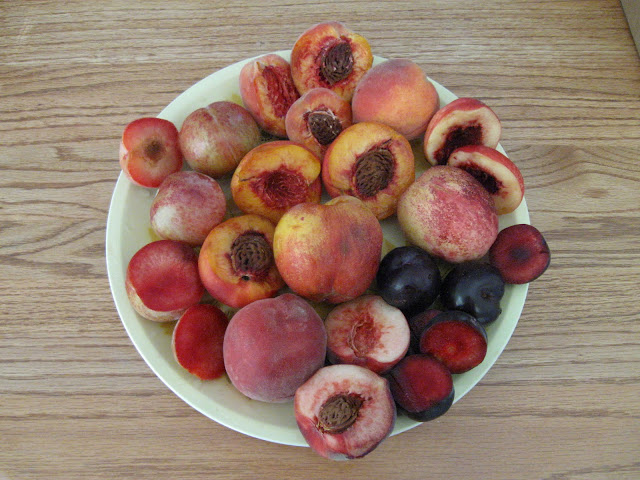Monday, August 16, 2010
Pluots and Sugar Plums
Last week, I picked samples of three varieties of Pluots and our only European plum:
The yellow ones at the top are Flavor Queen Pluots: Pure sweetness - too sweet for some people when fully ripe. Clingstone. This variety does not set fruit easily. I only have a few fruits this year.
To the right are Geo Pride Pluots - tender, flavorful, sweet. Semi-freestone when soft-ripe.
At the bottom are this year's first Sugar Plums - a small European variety which survives in our climate. They can be dried into prunes without special treatment. Sweet, like the typical prune-plum.
On the left are Dapple Dandy Pluots: Bumper crop this year, as most years. Firm, clingstone.
The yellow ones at the top are Flavor Queen Pluots: Pure sweetness - too sweet for some people when fully ripe. Clingstone. This variety does not set fruit easily. I only have a few fruits this year.
To the right are Geo Pride Pluots - tender, flavorful, sweet. Semi-freestone when soft-ripe.
At the bottom are this year's first Sugar Plums - a small European variety which survives in our climate. They can be dried into prunes without special treatment. Sweet, like the typical prune-plum.
On the left are Dapple Dandy Pluots: Bumper crop this year, as most years. Firm, clingstone.
Thursday, August 5, 2010
Summer Fruits
It's been seasonably hot - with highs around 100 degrees for several days, almost 40 degrees cooler just before sunup. The peaches and nectarines appreciate the weather more than the plums and Pluots do. But we have an assortment right now. Here is a platter full of fruits:
At the top are July Elberta peaches - freestone, suitable for canning (much less firm than cling peaches), great for jam, old-fashioned yellow peach flavor fresh. To the right are some of the last Heavenly White Nectarines - also freestone. Sweet, growing on a vigorous tree. Skin is slightly tough. I may not have watered enough when they were small. I would have bigger fruits on both of the varieties above if I had thinned more carefully.
Below the Heavenly White nectarines are some Burgundy plums. They are sweet, firm, quite mild and red all the way through. They hang well on the tree for quite a while without losing quality. Some people find them similar to Bing cherries. Clingstone. Recommended for drying if you're patient enough to cut the fruit off the pit. The blossoms are self-pollenizing and it is a good pollenizer for second-early blooming plums and Pluots.
At the bottom are Snow Beauty peaches. Freestone. A very nice white peach for California. Above them, in the center, are Fantasia nectarines - an old-fashioned, very flavorful variety - not as sweet as some of the newer ones. Freestone. A great fruit. I learned from "Fruitnut" on the Garden Web that this variety may not produce fruit if not watered well early in the season. I did better this year.
To the left are Dapple Dandy Pluots - the most well-known commercial Pluot. It was once promoted as "dinosaur eggs". Some of the mottled skin coloration comes from a plum parent - Mariposa. They grow on a vigorous, prolific tree. The fruit is firm and sweet. Clingstone. Not the most flavorful Pluot available, but still very tasty. There are some similar-looking varieties which ripen at different seasons which are very inferior in flavor. Their inferior flavor is even noted in the wholesale catalog for the trees. So try to make sure you get the real "Dapple Dandy" if you buy some at a farmer's market or something.
At the top are July Elberta peaches - freestone, suitable for canning (much less firm than cling peaches), great for jam, old-fashioned yellow peach flavor fresh. To the right are some of the last Heavenly White Nectarines - also freestone. Sweet, growing on a vigorous tree. Skin is slightly tough. I may not have watered enough when they were small. I would have bigger fruits on both of the varieties above if I had thinned more carefully.
Below the Heavenly White nectarines are some Burgundy plums. They are sweet, firm, quite mild and red all the way through. They hang well on the tree for quite a while without losing quality. Some people find them similar to Bing cherries. Clingstone. Recommended for drying if you're patient enough to cut the fruit off the pit. The blossoms are self-pollenizing and it is a good pollenizer for second-early blooming plums and Pluots.
At the bottom are Snow Beauty peaches. Freestone. A very nice white peach for California. Above them, in the center, are Fantasia nectarines - an old-fashioned, very flavorful variety - not as sweet as some of the newer ones. Freestone. A great fruit. I learned from "Fruitnut" on the Garden Web that this variety may not produce fruit if not watered well early in the season. I did better this year.
To the left are Dapple Dandy Pluots - the most well-known commercial Pluot. It was once promoted as "dinosaur eggs". Some of the mottled skin coloration comes from a plum parent - Mariposa. They grow on a vigorous, prolific tree. The fruit is firm and sweet. Clingstone. Not the most flavorful Pluot available, but still very tasty. There are some similar-looking varieties which ripen at different seasons which are very inferior in flavor. Their inferior flavor is even noted in the wholesale catalog for the trees. So try to make sure you get the real "Dapple Dandy" if you buy some at a farmer's market or something.
Subscribe to:
Posts (Atom)

